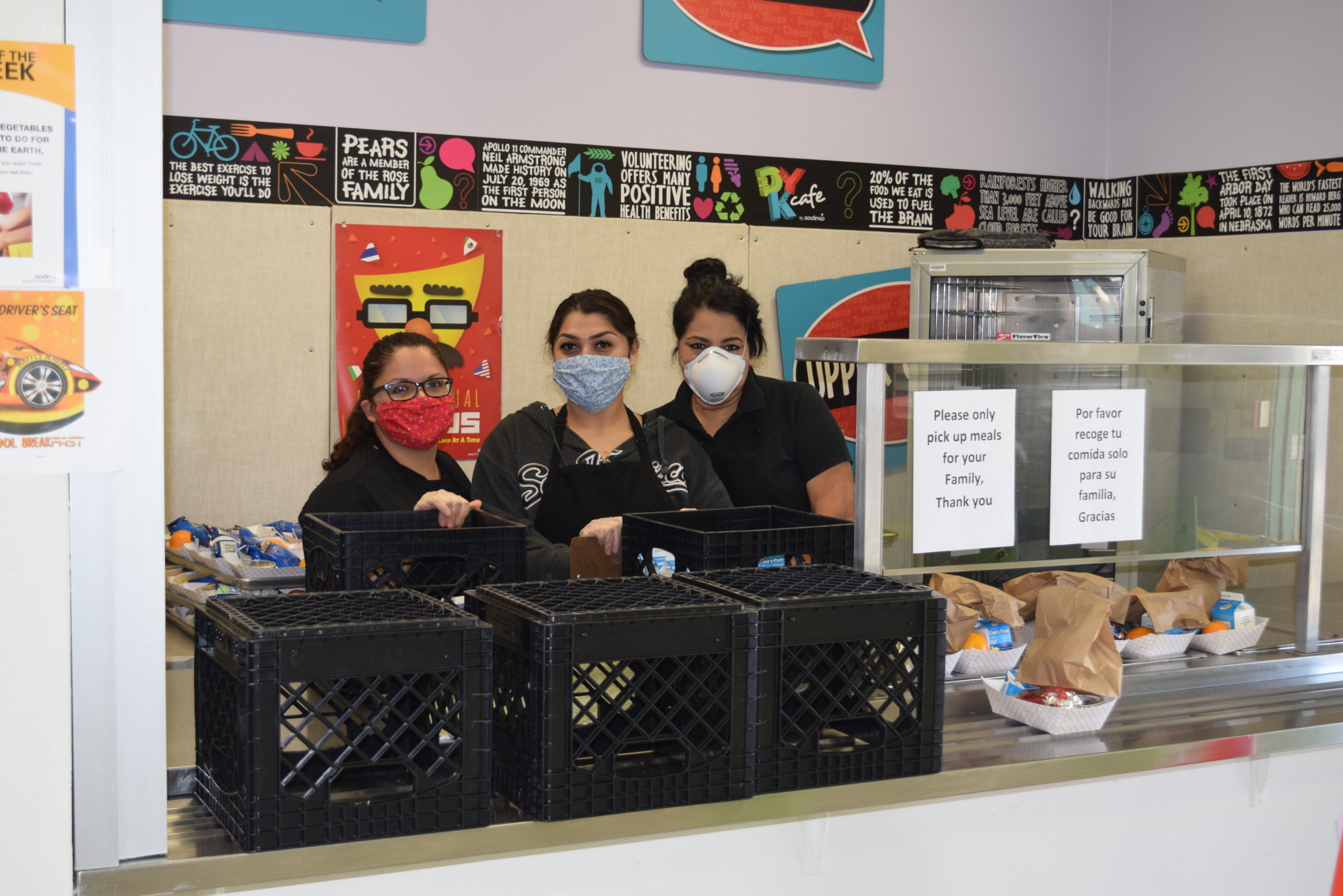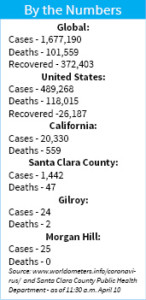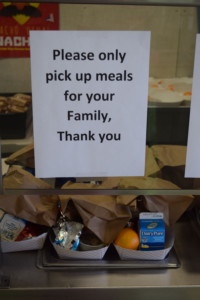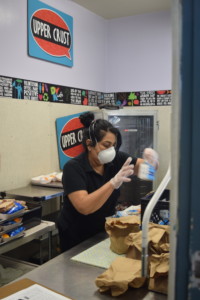Shelter in place extended through May 3 as COVID-19 cases rise
City has lost 80 percent in sales tax, nearly 90 percent in transient occupancy tax from coronavirus

Photo by Robert Airoldi — GUSD food service workers, from left, Jeanette Cervantes, Reyna Becerra and Marta Engen, pass out meals to Gilroy families. Since March 16, GUSD has handed out more than 40,000 meals.
By Robert Airoldi and Marty Cheek
As the shelter-in-place order enters 30 days in mid-April, Gilroy residents are feeling the stress. Some are working from home and homeschooling their children. Others are still commuting to “essential” jobs, while many others are filing for unemployment.
 Gilroy has had 24 confirmed cases of the 1,442 cases in the county, according to the Santa Clara County Public Health Department. Gilroy has had two deaths from COVID-19, an elderly man and woman. The county has had 47 deaths as of April 10. Morgan Hill has reported 25 cases.
Gilroy has had 24 confirmed cases of the 1,442 cases in the county, according to the Santa Clara County Public Health Department. Gilroy has had two deaths from COVID-19, an elderly man and woman. The county has had 47 deaths as of April 10. Morgan Hill has reported 25 cases.
With a population of more than a million, San Jose has had 958 cases, the most cases of any city in the Bay Area. All other cities in the county have had less than 50 confirmed cases.
The impact of the pandemic is having a huge hit on people’s lives as well as the business community in Gilroy, said Mayor Roland Velasco
‘We know that this is taking a toll on all sectors of the community whether you are a resident who is still fortunate to be able to work from home, to you’re a resident who lost their job, it’s still taking a toll on you. It’s different problems,” he said. “There’s a lot of impact all across the city. And then you couple that with the emotional impact. Most Americans live paycheck to paycheck and you have people struggling to figure out how am I going to make mortgage, how am I going to pay rent.”
The city has lost 80 percent of sales tax and close to 90 percent of transient occupancy tax (the hotel tax) due to the crisis, he said.
 While global, country and state numbers of COVID-19 continue to rise, Santa Clara County remains the epicenter of the coronavirus in the Bay Area, said Dr. Sara Cody, the county’s public health officer. Local hospitals are caring for patients with COVID-19 and while they are not yet at capacity, they are preparing for a surge. The county has set up a makeshift hospital at the Santa Clara Convention Center to take care of patients with the disease. County officials warn that, due to the limited testing ability for the disease, the number of cases is likely much higher than what is reported.
While global, country and state numbers of COVID-19 continue to rise, Santa Clara County remains the epicenter of the coronavirus in the Bay Area, said Dr. Sara Cody, the county’s public health officer. Local hospitals are caring for patients with COVID-19 and while they are not yet at capacity, they are preparing for a surge. The county has set up a makeshift hospital at the Santa Clara Convention Center to take care of patients with the disease. County officials warn that, due to the limited testing ability for the disease, the number of cases is likely much higher than what is reported.

Photo by Robert Airoldi
To preserve critical hospital capacity, public health officials in seven Bay Area jurisdictions extended the stay-at-home order through May 3. The previous three-week order was set to expire April 7 and it has been effective so far in reducing the rate of transmission of COVID-19, Cody said.
The reason for the extension is that health officers have seen a significant increase in the number of positive cases, hospitalization and deaths from COVID-19, which is beginning to strain healthcare resources. More and stricter social distancing is needed to slow the rate of spread, prevent deaths, and prevent the health care system from becoming overwhelmed.
The COVID-19 shelter-in-place is changing South Valley society dramatically. Streets and boulevards once bustling with traffic during rush hour are now virtually empty during peak commute hours. Many businesses are shuttered, and restaurants are allowing curbside pick-up of food and alcohol.
Superintendents across Santa Clara County including the Gilroy Unified School District notified parents classes would not reconvene physically for the rest of the 2019-2020 school year. Graduations were scheduled for early June. This impacts the 260,000 students attending classes in 31 districts in the county. GUSD will continue students’ education with online learning systems starting April 13, the first school day after the week of spring break.
 Teachers will use video conferencing platforms like WebEx to deliver lessons to their students. Students are expected to attend a virtual meeting and take notes and do whatever assignments are required for the class
Teachers will use video conferencing platforms like WebEx to deliver lessons to their students. Students are expected to attend a virtual meeting and take notes and do whatever assignments are required for the class
“I think that people are in various levels of acceptance. Some are in shock still. It runs the gamut of emotions,” said Melanie Corona, the public information officer for GUSD. “I feel terribly for our (high school) seniors. I’m devastated for them that they’re not going to have that special spring semester their senior year when they make their decisions about where they’re going after graduation, deciding on which college, and enjoying proms and senior trips.”
GUSD has committed to the class of 2020 that it will hold a graduation ceremony and is now working on what it will look like, she said. Public health is the top priority, everyone realizes.
“There’s a level of sadness in people, but there is also a level of understanding because it’s bigger than what my individual needs are as a person,” she said. “We have to be responsible. We have to take care of the members of our community who are vulnerable.”
To help families that rely on a nutritious school-time meal, GUSD is giving out hundreds of free lunches throughout the week to families that are need. As of April 10, more than 40,000 meals (a combo of lunch and breakfast) have been given out to families living in Gilroy who have children 18 years or younger.
Residents are required to stay at home except for doing essential activities, such as grocery shopping. Non-essential businesses will remain closed.
Dr. Cody, issued a new order April 8 requiring entities and individuals to report large inventories of personal protective equipment (PPE) and ventilators.
“Our goal is to ensure the capacity of our health care system by expanding the number of available hospital beds and by ensuring that the workforce that is providing care for patients has sufficient personal protective equipment,” said Dr. Jennifer Tong, Hospital Surge Capacity Branch Chief of the County of Santa Clara Emergency Operations Center.
“The community’s response to the shelter-in-place order has slowed the spread, providing more time for us to ensure the health care infrastructure can respond.” Dr. Cody said. “During this enormously challenging time, our collective action is what has been saving lives and this is another way we can continue that trajectory.”
The county also clarified language around essential business and activities, as well as some new directives:
- Use of playgrounds, dog parks, public picnic areas, and similar recreational areas is prohibited. These areas must be closed to public use.
- Use of shared public recreational facilities such as golf courses, tennis and basketball courts, pools, and rock walls is prohibited. These facilities must be closed for recreational use.
- Sports requiring people to share a ball or other equipment must be limited to people in the same household.
- Requires essential businesses to develop a social distancing protocol before April 3.
- Most construction — residential and commercial — is prohibited.
- Funerals are limited to no more than 10 people attending.
- The Answer Man - April 19, 2024
- Around Town … with Robert Airoldi: See some of the beautiful quilts at the AAUW show May 18 at the IFDES Lodge - April 17, 2024
- Archive April 24 – May 7, 2024 - April 17, 2024
